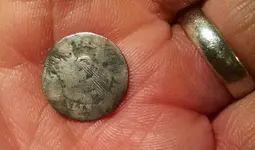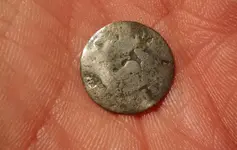Garandomatic
Tenderfoot
- Joined
- Mar 27, 2016
- Messages
- 4
- Reaction score
- 7
- Golden Thread
- 0
- Primary Interest:
- All Treasure Hunting
New here, and hope that someone can help me figure out exactly what this is...
When I was a kid, every time we plowed the fields, my dad and grandpa would take me arrowhead hunting. Between the three of us, we amassed an interesting collection of points and other artifacts, usually pre-1492, as far back as Paleo. In a bottom field on the farm (SE Ohio) I found this sticking out of a plow cut. It's about the size of a dime, very thin. A few ears ago I thought I found another coin on the internet with similar markings that led me to believe that it is French, and from the 1600s. Out of curiosity, I have tried to definitively ID it, but without luck. I took these photos with my phone, but can scan it for higher resolution after the weekend is over. Native Americans around the farm would have had trade contact with British and French, but as extensive as the trade networks they had were, I suppose it could even be Dutch or Spanish, though I think I see a part of a Fleur de Lis on one side.
When I was a kid, every time we plowed the fields, my dad and grandpa would take me arrowhead hunting. Between the three of us, we amassed an interesting collection of points and other artifacts, usually pre-1492, as far back as Paleo. In a bottom field on the farm (SE Ohio) I found this sticking out of a plow cut. It's about the size of a dime, very thin. A few ears ago I thought I found another coin on the internet with similar markings that led me to believe that it is French, and from the 1600s. Out of curiosity, I have tried to definitively ID it, but without luck. I took these photos with my phone, but can scan it for higher resolution after the weekend is over. Native Americans around the farm would have had trade contact with British and French, but as extensive as the trade networks they had were, I suppose it could even be Dutch or Spanish, though I think I see a part of a Fleur de Lis on one side.





